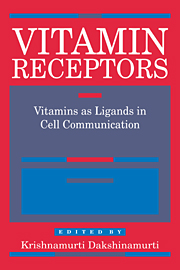Book contents
- Frontmatter
- Contents
- List of contributors
- Preface
- Introduction
- 1 Serum and cellular retinoid-binding proteins
- 2 Retinoic acid receptors
- 3 Vitamin D receptors and the mechanism of action of 1,25-dihydroxyvitamin D3
- 4 Cobalamin binding proteins and their receptors
- 5 Folate binding proteins
- 6 Riboflavin carrier protein in reproduction
- 7 Binding proteins for α-tocopherol, L-ascorbic acid, thiamine amd vitamin B6
- 8 Biotin-binding proteins
- List of abbreviations
- Index
6 - Riboflavin carrier protein in reproduction
Published online by Cambridge University Press: 06 January 2010
- Frontmatter
- Contents
- List of contributors
- Preface
- Introduction
- 1 Serum and cellular retinoid-binding proteins
- 2 Retinoic acid receptors
- 3 Vitamin D receptors and the mechanism of action of 1,25-dihydroxyvitamin D3
- 4 Cobalamin binding proteins and their receptors
- 5 Folate binding proteins
- 6 Riboflavin carrier protein in reproduction
- 7 Binding proteins for α-tocopherol, L-ascorbic acid, thiamine amd vitamin B6
- 8 Biotin-binding proteins
- List of abbreviations
- Index
Summary
Introduction
One of the major advances in our current understanding of the processes evolved to ensure optimal bioavailability of the fat- and water-soluble vitamins for growth, metabolism and reproduction of the vertebrates is the discovery of a group of soluble proteins in the blood and other body fluids which stoichiometrically and reversibly bind the respective vitamins with high affinity and receptor-like specificity, and often carry them to distant sites of utilization. A great deal of information is now available regarding these proteins’ basic structural features, ligand-binding characteristics and physiological functions; the latter may include dietary absorption, storage, circulatory transport and prevention of rapid loss due to excretion or catabolism. Vitamins are known to remain biologically inert during the tight, yet non-covalent, association with their respective carriers, thereby permitting a reversible dissociation of the unmodified vitamins for utilization in a form and at sites most appropriate physiologically. Additionally, such an interaction of the fat-soluble vitamins with their respective soluble carrier proteins facilitates their transport in circulation in a water-soluble form.
Some of these vitamin carriers, notably those specific to fat-soluble vitamins, folic acid and cobalamine, are constitutively present ubiquitously throughout the animal kingdom and their elaboration may be significantly enhanced by appropriate stimuli to meet the accelerated demand during growth and reproduction. In contrast, others such as those specific to riboflavin and thiamin are apparently induced de novo, mostly, if not solely, as a reproductive stratagem to facilitate vitamin deposition in the developing oocytes in oviparous species and to transport the micronutrients through the physiological barriers (such as that offered by the placenta) in the mammals.
- Type
- Chapter
- Information
- Vitamin ReceptorsVitamins as Ligands in Cell Communication - Metabolic Indicators, pp. 137 - 176Publisher: Cambridge University PressPrint publication year: 1994
- 8
- Cited by

